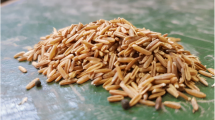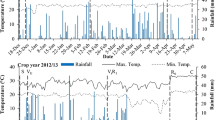Abstract
Mixed cropping of lentil (Lens culinaris) with five spring-sown companion crops: naked barley (Hordeum vulgare), wheat (Triticum aestivum), oats (Avena sativa), linseed (Linum usitatissimum) and buckwheat (Fagopyrum esculentum) was compared with monocropping at the organic research station Kleinhohenheim, University of Hohenheim, Germany, in 2009 and 2010. Besides sole lentil and sole companion crops, three mixing ratios (3:1, 1:1 and 1:3) were used. The aim of the study was to identify the most suitable companion crop and mixing ratio for lentils in terms of yield, weed infestation and lodging under temperate climatic conditions. Lentils yielded 1.47 t ha−1 in monocropping and 0.58–1.07 t ha−1 in mixed cropping, depending on the mixing ratio and companion crop. The land equivalent ratio (LER) was higher in mixed cropping than monocropping generally. Lentil–wheat and lentil–barley mixed cropping with a ratio of 3:1 resulted in the highest LER (ca. 1.50); lentil–linseed had the lowest LER for all ratios. Least lodging was observed in lentil–wheat and lentil–oat mixed cropping. Compared with lentil monocropping, mixed cropping with ratios of 3:1, 1:1 and 1:3 (lentil/companion/crop) reduced weed biomass by 29, 41 and 24 %, respectively. Mixed cropping with wheat and barley for lentil in central Europe gives marked benefits in terms of grain yield, weed control and crop lodging resistance. Lentil production in organic farming systems is well suited to mixed cropping approaches.




Similar content being viewed by others
Abbreviations
- B:
-
Barley
- Bw:
-
Buckwheat
- CC:
-
Companion crop
- L:
-
Lentil
- LAI:
-
Leaf area index
- Ls:
-
Linseed
- Mono:
-
Monocropping
- O:
-
Oat
- W:
-
Wheat
References
Agegnehu G, Ghizaw A, Sinebo W (2006) Yield performance and land-use efficiency of barley and faba bean mixed cropping in Ethiopian highlands. Eur J Agron 25:202–207
Ahlawat IPS, Singh A, Sharma RP (1985) Water and nitrogen management in wheat lentil intercropping system under late-sown conditions. J Agric Sci (Camb) 105:697–701
Akter N, Alim MA, Mahbubul Islam M, Naher Z, Rahman M, Iqbal Hossain ASM (2004) Evaluation of mixed and intercropping of lentil and wheat. J Agron 3:48–51
Banik P, Midya A, Sarkar BK, Ghose SS (2006) Wheat and chickpea intercropping systems in an additive series experiment: advantages and weed smothering. Eur J Agron 24:325–332
BMELV (Federal Ministry of Food, Agriculture and Consumer Protection) (2011) Organic farming in Germany. http://www.bmelv.de/SharedDocs/Standardartikel/EN/Agriculture/OrganicFarming/OrganicFarmingInGermany.html#doc381512bodyText4. Accessed 13 Feb 2012
Brouwer JB, Sharma B, Malik BA, Hill GD (2000) Asia-Pacific: meeting the challenge. In: Knight R (ed) Linking research and marketing opportunities for pulses in the 21st century. Kluwer, Dordrecht, pp 115–130
Carr MP, Gardner CJ, Schatz GB, Zwinger WS, Guldan JS (1995) Grain yield and weed biomass of a wheat–lentil intercrop. Agron J 87:574–579
Ciftci V, Ulker M (2005) Effect of mixed cropping lentil with wheat and barley at different seeding ratios. J Agron 4:1–4
EC (European Commission) (2010) An analysis of the EU organic sector. http://ec.europa.eu/agriculture/analysis/markets/organic_2010_en.pdf. Accessed 13 Feb 2012
FAO (2010) FAOSTAT. http://faostat.fao.org/site/567/DesktopDefault.aspx?PageID=567#ancor. Accessed 13 Oct 2010
Gangasaran G, Giri G (1985) Intercropping of mustard with chickpea, lentil and barley in drylands. Indian J Agron 30:244–250
Hauggaard-Nielsen H, Ambus P, Jensen ES (2001) Interspecific competition, N use and interference with weeds in pea–barley intercropping. Field Crops Res 70:101–109
Hooks CRR, Valenzuela HR, Defrank J (1998) Incidence of pests and arthropod natural enemies in zucchini grown with living mulches. Agric Ecosyst Environ 69:217–231
Horneburg B (2006) Short communication: outcrossing in lentil (Lens culinaris) depends on cultivar, location and year, and varies within cultivars. Plant Breed 125:638–640
SAS Institute (2009) The SAS system for Windows Release 9.2. SAS Institute, Cary
Liebman M, Dyck E (1993) Crop rotation and intercropping strategies for weed management. Ecol Appl 3:92–122
Mandal BK, Dhara MC, Mandal BB, Das SK, Nandy R (1990) Rice, mungbean, soybean, peanut, ricebean and blackgram yields under different intercropping systems. Agron J 82:1063–1066
McVicar R, McCall P, Brenzil C, Hartley S, Panchuk K, Mooleki P, Vandenberg A, Banniza S. Revised by Risula R (2010) Lentil in Saskatchewan. http://www.agriculture.gov.sk.ca/Default.aspx?DN=c5993bcc-009f-4031-b936-c52c992b9e7d. Accessed 22 Dec. 2010
Muehlbauer FJ, Short RW, Summerfield RJ, Morrison KJ, Swan DG (1981) Description and culture of lentils. Coop Ext Serv Circ EB-0957. Washington State University, Pullman
Muehlbauer FJ, Kaiser WJ, Clement SL, Summerfield RJ (1995) Production and breeding of lentil. Adv Agron 54:283–332
Ofori F, Stern WR (1987) Cereal–legume intercropping systems. Adv Agron 41:41–90
Olasantan FO, Lucas EO, Ezumah HC (1994) Effects of intercropping and fertilizer application on weed control and performance of cassava and maize. Field Crops Res 39:63–69
Patrick MC, Gardner JC, Schatz BG, Zwinger SW, Guldan SJ (1995) Grain yield and weed biomass of a wheat–lentil intercrop. Agron J 87:574–579
Patterson HD (1997) Analysis of series of variety trials. In: Kempton RA, Fox PN (eds) Statistical methods for plant variety evaluation. Chapman and Hall, London, pp 139–161
Sekhon HS, Singh G, Ram H (2007) Lentil-based cropping systems. In: Yadav SS et al (eds) Lentil: an ancient crop for modern times. Springer, Berlin, pp 107–126
Siddique KHM, Loss SP, Pritchard DL, Regan KL, Tennant D, Jettner RL, Wilkinson D (1998) Adaptation of lentil (Lens culinaris Medik.) to Mediterranean-type environments: effect of time of sowing on growth, yield, and water use. Aust J Agric Res 49:613–626
Szumigalski A, Rene V (2005) Weed suppression and crop production in annual intercrops. Weed Sci 53:813–825
Vlachostergios DN, Lithourgidis AS, Roupakias DG (2011) Adaptability to organic farming of lentil (Lens culinaris Medik.) varieties developed from conventional breeding programmes. J Agric Sci 149:85–93
Willey RW (1979) Intercropping—its importance and research needs. Part Ι. Competition and yield advantages. Field Crop Abstr 32:1–10
Yagmur M, Kaydan D (2006) Different intercrop arrangements with lentil and barley under dryland condition. Pak J Biol Sci 9(10):1917–1922
Acknowledgments
We sincerely thank Ilona Weikert, Oliver Hübner and Rainer Funk who supported the field work from sowing to harvesting, and also Andrea Rückle for giving help in the laboratory work. We thank Woldemar Mammel and the Öko-EZG “Albleisa” for providing the seeds and for other advice and assistance. The authors also thank Jens Möhring for supporting the statistical analysis.
Author information
Authors and Affiliations
Corresponding author
Rights and permissions
About this article
Cite this article
Wang, L., Gruber, S. & Claupein, W. Optimizing lentil-based mixed cropping with different companion crops and plant densities in terms of crop yield and weed control. Org. Agr. 2, 79–87 (2012). https://doi.org/10.1007/s13165-012-0028-5
Received:
Accepted:
Published:
Issue Date:
DOI: https://doi.org/10.1007/s13165-012-0028-5




